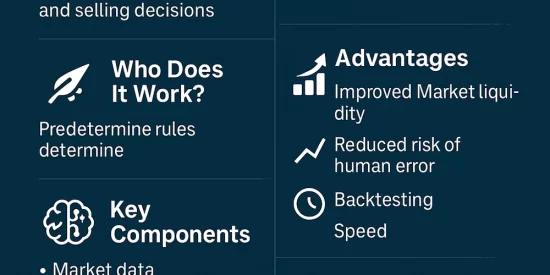🚀 Introduction to Algorithmic Trading: The Future of Financial Markets
Algorithmic trading is reshaping the world of finance, allowing traders to make decisions faster, smarter, and more efficiently than ever before. Whether you’re a curious beginner or a tech-savvy trader, this guide will give you a solid introduction to the world of algo-trading.
Let’s break it down! 👇
🤖 What is Algorithmic Trading?
Algorithmic trading, also known as algo-trading, is the process of using computer programs to execute trades automatically based on pre-defined rules and strategies.
These rules are based on price, volume, timing, or other mathematical models — and they work without human intervention.
📈 Why is Algorithmic Trading So Popular?
Here are some of the reasons why algo-trading has become a major trend:
- ⚡ Speed: Execute thousands of trades in milliseconds.
- 💰 Cost-Efficiency: Lower transaction costs.
- 📊 Accuracy: No emotional bias — purely data-driven.
- 🔁 Automation: Systems can run 24/7.
🧠 How Does It Work?
Algo-trading works in a few steps:
- Data Collection – Gather market data in real-time.
- Signal Generation – Based on strategies, the algorithm decides when to trade.
- Execution – The trade is executed instantly.
- Risk Management – Ensure stop losses, limits, and rules are in place.
🔍 Common Algo-Trading Strategies
- Trend Following: Trade in the direction of the trend (e.g. moving averages).
- Arbitrage: Exploit price differences across exchanges.
- Mean Reversion: Buy low, sell high based on average price.
- Market Making: Provide liquidity by quoting bid and ask prices.
🔧 Key Components of an Algorithmic Trading System
- Market Data Feed
- Trading Algorithm (the brain!)
- Backtesting Engine
- Execution Platform
- Risk Management Layer
📉 Tools & Technologies to Learn
If you want to get started, explore these:
- 🐍 Python — with libraries like
pandas,numpy,scikit-learn - 🔍 Backtesting Platforms — QuantConnect, Backtrader
- 📈 Broker APIs — like Interactive Brokers or Alpaca
- 🧠 ML Libraries — TensorFlow, PyTorch for predictive models
⚠️ Challenges in Algo Trading
Not everything is smooth sailing:
- 🧨 Technical glitches or bugs can be catastrophic
- 📉 Market impact of large trades
- ⚖️ Regulatory concerns
- 🏁 High competition with established HFT firms
✅ Best Practices
- Always backtest your strategy before live trading.
- Keep risk management rules strict and simple.
- Monitor performance and adapt constantly.
- Don’t chase profits — focus on consistent improvement.
💬 Final Thoughts
Algorithmic trading is a fusion of finance and technology. It’s powerful, fast, and scalable — but it also requires discipline, constant learning, and a data-first mindset.
Whether you’re building your first trading bot or refining your strategy, remember: the market rewards those who stay curious and consistent.
Enjoyed this post?
Follow me @learn_with_san for more insights on coding, and building in public. 🚀
Drop your thoughts, questions, or tools you’ve used below! 👇
algotrading #trading #finance #python #quantitativeanalysis #developer





